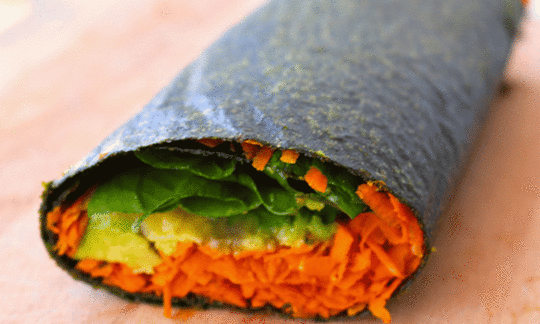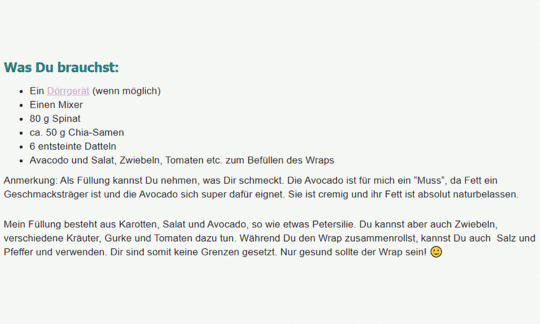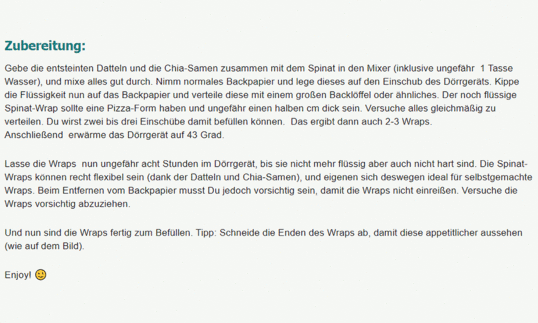Raw vegan spinach wrap with avocado and chia seeds
raw-vegan
Ingredients (for servings, )
| 2 ¾ oz | Spinach, raw (vegetable spinach) |
| 6 | Dates, variety Deglet Nour, pitted, raw?, (organic?) (1.5 oz) |
| 1 ¾ oz | Chia (chia seeds), raw, organic? |
| 250 ml | Drinking water, raw (organic?) (8.8 oz) |
| ½ | Avocados, raw (organic?) (3.5 oz) |
Equipment
- blender
- dehydrator
Type of preparation
- dehydrate
- food preparation without heating
- blend
Preparation
Preparation
Wash the spinach. Put the pitted dates and chia seeds into the blender along with the washed spinach. Add about 1 cup of water and mix well.It doesn't matter which type of dates you use.
Take normal baking paper and place it on the tray of the dehydrator. Pour a third to a maximum of half of the mixture onto the baking paper and spread it out with a large baking spoon. The spinach wrap, which is still liquid, should have a pizza shape and be about half a centimeter thick and even.
Julia: You will be able to fill two to three trays with it. This will give you 2-3 wraps. Then heat the dehydrator to 43 °C.
Dörren
Leave the wraps in the dehydrator for about eight hours, until they are no longer liquid but not too hard either. The spinach wraps can be quite flexible (thanks to the dates and chia seeds) and are therefore ideal for homemade wraps. Peel them off carefully.Julia: Be careful when removing the wraps from the baking paper so that they don't tear. Try to peel the wraps off carefully.
filling the wraps
Peel the avocado and cut into thin strips.
Other suitable fillings include carrots, lettuce, onions, various herbs, cucumbers and tomatoes.
|
Nutritional Information per person
Convert per 100g
|
2000 kcal | |
|---|---|---|
| Energy | 271 kcal | 13.6% |
| Fat/Lipids | 15 g | 21.8% |
| Saturated Fats | 1.9 g | 9.7% |
| Carbohydrates (inc.dietary fiber) | 32 g | 11.9% |
| Sugars | 14 g | 15.5% |
| Fiber | 15 g | 58.2% |
| Protein/Albumin | 6.8 g | 13.6% |
| Cooking Salt (Na:44.5 mg) | 113 mg | 4.7% |
| Essential micronutrients with the highest proportions | per person | 2000 kcal | |
|---|---|---|---|
| Vit | Vitamin K | 204 µg | 272.0% |
| Fat | Alpha-Linolenic acid; ALA; 18:3 omega-3 | 4.6 g | 228.0% |
| Vit | Vitamin B9, B11 (Folate, as the active form of folic acid) | 135 µg | 67.0% |
| Min | Manganese, Mn | 1.2 mg | 58.0% |
| Prot | Tryptophan (Trp, W) | 0.14 g | 56.0% |
| Min | Copper, Cu | 0.44 mg | 44.0% |
| Elem | Phosphorus, P | 274 mg | 39.0% |
| Elem | Magnesium, Mg | 140 mg | 37.0% |
| Elem | Potassium, K | 708 mg | 35.0% |
| Prot | Threonine (Thr, T, irreversibly transaminated) | 0.27 g | 29.0% |
Detailed Nutritional Information per Person for this Recipe
The majority of the nutritional information comes from the USDA (US Department of Agriculture). This means that the information for natural products is often incomplete or only given within broader categories, whereas in most cases products made from these have more complete information displayed.
If we take flaxseed, for example, the important essential amino acid ALA (omega-3) is only included in an overarching category whereas for flaxseed oil ALA is listed specifically. In time, we will be able to change this, but it will require a lot of work. An “i” appears behind ingredients that have been adjusted and an explanation appears when you hover over this symbol.
For Erb Muesli, the original calculations resulted in 48 % of the daily requirement of ALA — but with the correction, we see that the muesli actually covers >100 % of the necessary recommendation for the omega-3 fatty acid ALA. Our goal is to eventually be able to compare the nutritional value of our recipes with those that are used in conventional western lifestyles.
| Essential fatty acids | per person | 2000 kcal |
|---|---|---|
| Alpha-Linolenic acid; ALA; 18:3 omega-3 | 4.6 g | 228.0% |
| Linoleic acid; LA; 18:2 omega-6 | 2.3 g | 23.0% |
| Essential amino acids | per person | 2000 kcal |
|---|---|---|
| Tryptophan (Trp, W) | 0.14 g | 56.0% |
| Threonine (Thr, T, irreversibly transaminated) | 0.27 g | 29.0% |
| Isoleucine (Ile, I) | 0.31 g | 25.0% |
| Phenylalanine (Phe, F) | 0.36 g | 24.0% |
| Valin (Val, V) | 0.37 g | 23.0% |
| Leucine (Leu, L) | 0.52 g | 22.0% |
| Lysine (Lys, K, irreversibly transaminated) | 0.39 g | 21.0% |
| Methionine (Met, M) | 0.19 g | 21.0% |
| Vitamins | per person | 2000 kcal |
|---|---|---|
| Vitamin K | 204 µg | 272.0% |
| Vitamin B9, B11 (Folate, as the active form of folic acid) | 135 µg | 67.0% |
| Vitamin A, as RAE | 192 µg | 24.0% |
| Vitamin B3 (Niacin) | 3.6 mg | 23.0% |
| Vitamin C (ascorbic acid) | 17 mg | 21.0% |
| Vitamin B1 (Thiamine) | 0.23 mg | 21.0% |
| Vitamin B6 (pyridoxine) | 0.24 mg | 17.0% |
| Vitamin E, as a-TEs | 2.0 mg | 17.0% |
| Vitamin B2 (Riboflavin) | 0.20 mg | 14.0% |
| Vitamin B5 (Pantothenic acid) | 0.85 mg | 14.0% |
| Vitamin B7 (Biotin, ex vitamin H) | 6.9 µg | 14.0% |
| Essential macroelements (macronutrients) | per person | 2000 kcal |
|---|---|---|
| Phosphorus, P | 274 mg | 39.0% |
| Magnesium, Mg | 140 mg | 37.0% |
| Potassium, K | 708 mg | 35.0% |
| Calcium, Ca | 215 mg | 27.0% |
| Sodium, Na | 45 mg | 6.0% |
| Essential trace elements (micronutrients) | per person | 2000 kcal |
|---|---|---|
| Manganese, Mn | 1.2 mg | 58.0% |
| Copper, Cu | 0.44 mg | 44.0% |
| Selenium, Se | 15 µg | 27.0% |
| Iron, Fe | 3.5 mg | 25.0% |
| Zinc, Zn | 1.8 mg | 18.0% |
| Fluorine, F | 93 µg | 3.0% |
| Iod, I (Jod, J) | 5.1 µg | 3.0% |
The raw vegan spinach wrap with avocado and chia seeds can be filled with salad and vegetables as desired (filling not listed)
Serving size: The recipe listed includes the wrap including avocado. The other filling is not listed in the ingredients.
Nutrient profile: According to GDA guidelines, one portion of this dish covers more than twice the average daily requirement of vitamin K and omega-3 fatty acids. It also contains over 50% of the daily requirement of folic acid, manganese and tryptophan. The omega-6 and omega-3 fatty acids are in a very good ratio of 1:2 and thus far below the recommended maximum ratio of 5:1.
Spinach: Spinach (vegetable spinach) is rich in vitamins and minerals. Despite its high oxalic acid content, even raw spinach is healthy in reasonable amounts. Spinach contains a lot of vitamin K and folic acid, but also pro-vitamin A and vitamin C. Spinach contains iron, but not in as high quantities as originally thought. However, even after the correction to 2.71 mg/100 g, spinach still contains more iron than almost any other vegetable. 500 g practically cover the daily iron requirement.
Chia seeds: Chia seeds, which come from Mexico, are particularly characterized by their high content of calcium, iron, soluble fiber and omega-3 fatty acids. The iron content is about twice as high as in grains. Furthermore, the human organism can use the proportion of the amino acid tryptophan to convert it into the neurotransmitter serotonin via the enzymes tryptophan hydroxylase (TPH) and aromatic L-amino acid decarboxylase (AADC). The latter is generally considered to be a mood enhancer by conveying feelings of calm and inner satisfaction.
Avocado: Raw avocado is enjoyed primarily in the form of homemade dips or as an oil substitute in salads if you want to practice "clean eating", i.e. natural, raw vegan food or natural food instead of processed food. Raw avocados are very helpful here, even if they do not have a good LA:ALA ratio (the two essential fatty acids) of 15:1. See the table for raw avocados, but this can be balanced out with chia seeds, for example. See also pea muesli.
Recommended consumption of spinach: You should not store raw or cooked spinach at room temperature for long periods (around a week). Spinach contains a lot of nitrate, which bacteria convert into harmful nitrite. This can cause problems, especially in children, as it impairs the transport of oxygen in the body and the effects depend on both the amount consumed and body weight. Furthermore, the presence of certain amino acids can convert existing nitrites into carcinogenic nitrosamines when heated at the same time.
Storage of chia seeds: Chia seeds can be stored for up to 5 years and are therefore much more storable than, for example, flax seeds. Optimal storage conditions are achieved by using a good seal (e.g. screw-top jar) and storing in a dark, cool (but not damp) place.
Use the potential of chia seeds: Our body can benefit from the effects of many ingredients, especially by eating ground seeds, as the seeds in unground form are mainly used as fiber. Omega-3 fatty acids in particular should be given greater importance in our diet. Please read the link behind this motivation: Vegans often eat unhealthily. Avoidable nutritional errors.
Filling: As a filling, you can use avocado as well as various vegetables and herbs, such as carrots, lettuce, onions, cucumbers and tomatoes. If necessary, you can season lightly with pepper and salt. However, we recommend keeping the salt content as low as possible. Read the book review by Michael Moss Salt Sugar Fat.







